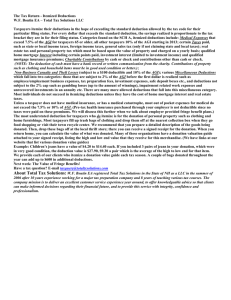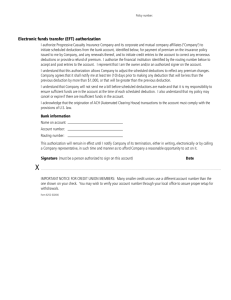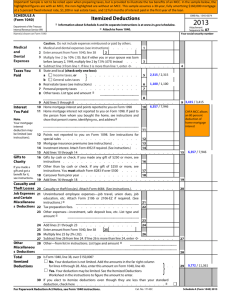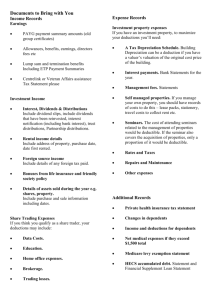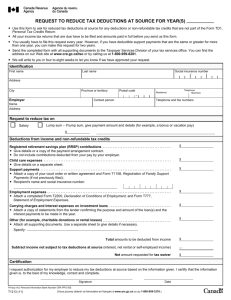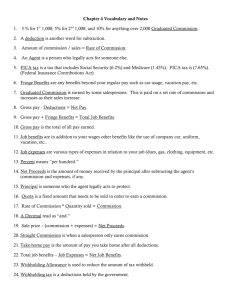Schedule A - University of Illinois Tax School
advertisement
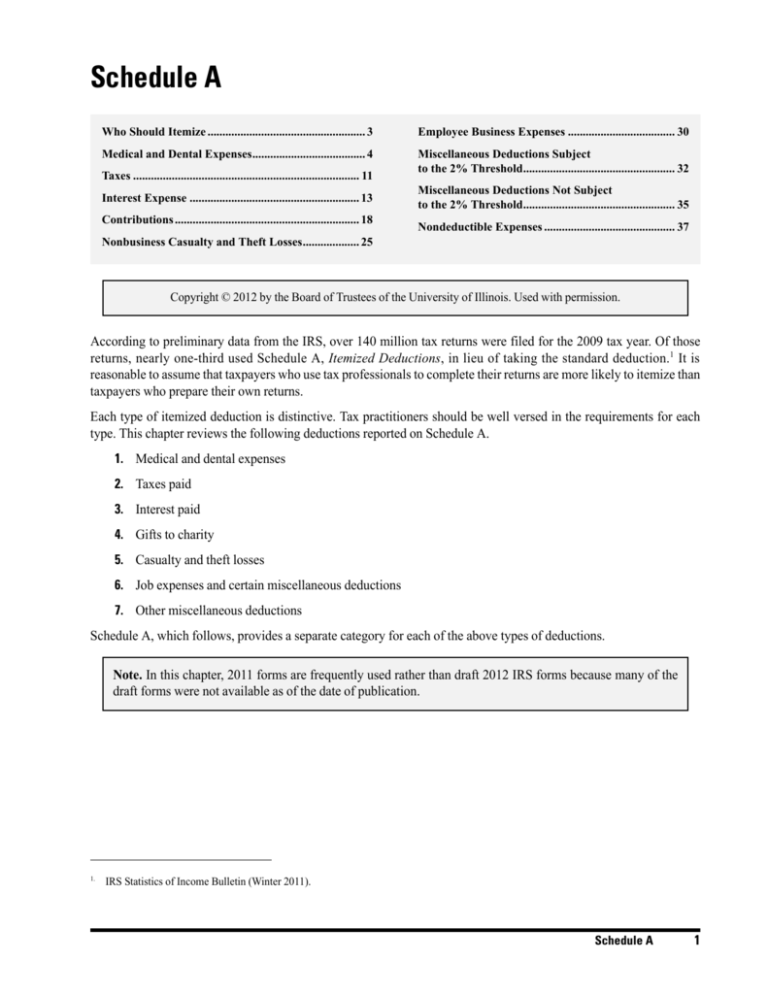
Schedule A Who Should Itemize ..................................................... 3 Employee Business Expenses .................................... 30 Medical and Dental Expenses...................................... 4 Miscellaneous Deductions Subject to the 2% Threshold................................................... 32 Taxes ............................................................................ 11 Interest Expense ......................................................... 13 Contributions .............................................................. 18 Miscellaneous Deductions Not Subject to the 2% Threshold................................................... 35 Nondeductible Expenses ............................................ 37 Nonbusiness Casualty and Theft Losses................... 25 Copyright © 2012 by the Board of Trustees of the University of Illinois. Used with permission. According to preliminary data from the IRS, over 140 million tax returns were filed for the 2009 tax year. Of those returns, nearly one-third used Schedule A, Itemized Deductions, in lieu of taking the standard deduction.1 It is reasonable to assume that taxpayers who use tax professionals to complete their returns are more likely to itemize than taxpayers who prepare their own returns. Each type of itemized deduction is distinctive. Tax practitioners should be well versed in the requirements for each type. This chapter reviews the following deductions reported on Schedule A. 1. Medical and dental expenses 2. Taxes paid 3. Interest paid 4. Gifts to charity 5. Casualty and theft losses 6. Job expenses and certain miscellaneous deductions 7. Other miscellaneous deductions Schedule A, which follows, provides a separate category for each of the above types of deductions. Note. In this chapter, 2011 forms are frequently used rather than draft 2012 IRS forms because many of the draft forms were not available as of the date of publication. 1. IRS Statistics of Income Bulletin (Winter 2011). Schedule A 1 Itemized Deductions SCHEDULE A (Form 1040) Department of the Treasury Internal Revenue Service (99) a Attach to Form 1040. a See OMB No. 1545-0074 2011 Instructions for Schedule A (Form 1040). Attachment Sequence No. 07 Your social security number Name(s) shown on Form 1040 Medical and Dental Expenses Taxes You Paid Interest You Paid Note. Your mortgage interest deduction may be limited (see instructions). Caution. Do not include expenses reimbursed or paid by others. Medical and dental expenses (see instructions) . . . . . 1 Enter amount from Form 1040, line 38 2 Multiply line 2 by 7.5% (.075) . . . . . . . . . . . 3 Subtract line 3 from line 1. If line 3 is more than line 1, enter -0- . . State and local (check only one box): a Income taxes, or . . . . . . . . . . . 5 b General sales taxes 6 Real estate taxes (see instructions) . . . . . . . . . 6 7 Personal property taxes . . . . . . . . . . . . . 7 8 Other taxes. List type and amount a 8 9 Add lines 5 through 8 . . . . . . . . . . . . . . . . 10 Home mortgage interest and points reported to you on Form 1098 10 1 2 3 4 5 . . . . . . 4 . . . . . . 9 . . . . . . 15 . . . . . . 19 } 11 Home mortgage interest not reported to you on Form 1098. If paid to the person from whom you bought the home, see instructions and show that person’s name, identifying no., and address a 11 12 Points not reported to you on Form 1098. See instructions for special rules . . . . . . . . . . . . . . . . . 12 13 Mortgage insurance premiums (see instructions) . . . . . 13 14 Investment interest. Attach Form 4952 if required. (See instructions.) 14 15 Add lines 10 through 14 . . . . . . . . . . . . . . . Gifts to 16 Gifts by cash or check. If you made any gift of $250 or more, see instructions . . . . . . . . . . . . . . . . 16 Charity 17 Other than by cash or check. If any gift of $250 or more, see If you made a gift and got a instructions. You must attach Form 8283 if over $500 . . . 17 benefit for it, 18 Carryover from prior year . . . . . . . . . . . . 18 see instructions. 19 Add lines 16 through 18 . . . . . . . . . . . . . . . Casualty and Theft Losses 20 Casualty or theft loss(es). Attach Form 4684. (See instructions.) . . . . . . . . Job Expenses 21 Unreimbursed employee expenses—job travel, union dues, and Certain job education, etc. Attach Form 2106 or 2106-EZ if required. Miscellaneous 21 (See instructions.) a Deductions 22 Tax preparation fees . . . . . . . . . . . . . 22 20 23 Other expenses—investment, safe deposit box, etc. List type and amount a Other Miscellaneous Deductions 24 25 26 27 28 23 Add lines 21 through 23 . . . . . . . . . . . . 24 Enter amount from Form 1040, line 38 25 Multiply line 25 by 2% (.02) . . . . . . . . . . . 26 Subtract line 26 from line 24. If line 26 is more than line 24, enter -0- . Other—from list in instructions. List type and amount a . . . . . 27 28 Total 29 Add the amounts in the far right column for lines 4 through 28. Also, enter this amount on Form 1040, line 40 . . . . . . . . . . . . . . . . . . . . . 29 Itemized Deductions 30 If you elect to itemize deductions even though they are less than your standard deduction, check here . . . . . . For Paperwork Reduction Act Notice, see Form 1040 instructions. 2 Schedule A . . . . . . . . . . Cat. No. 17145C . . . a Schedule A (Form 1040) 2011 WHO SHOULD ITEMIZE Most taxpayers can choose whether to itemize deductions or use the standard deduction. However, there are some taxpayers who must itemize deductions even when it is not advantageous for them to do so. The following taxpayers must itemize deductions because they cannot use the standard deduction. • Taxpayers who are nonresident aliens or dual-status aliens during the year • Taxpayers who are filing a short-year tax return because of a change in their annual accounting method • Taxpayers who are married filing separately (MFS) and whose spouse itemizes deductions A taxpayer’s standard deduction is zero when their filing status is MFS and their spouse itemizes deductions. This does not apply to taxpayers who file using the head of household (HoH) filing status, because they are considered unmarried for tax purposes. Therefore, taxpayers filing HoH are not subject to the zero standard deduction, even if they are legally married to someone who files a return using the MFS status and itemizes. However, the reverse is not true. The taxpayer filing MFS must use the zero standard deduction if their spouse itemizes, whether that spouse files as MFS or HoH. Example 1. Tula and Claude Popp separated in June 2012. Their son Hu lives with Tula after the separation. They do not file for divorce or legal separation during the year. Tula incurs significant travel expenses related to her employment. These expenses coupled with her other allowable deductions makes her itemized deductions for 2012 more than the standard deduction of $8,7002 for HoH filers. Therefore, she completes Schedule A for her 2012 return. Claude has been living in an apartment and his only deductible expense is the state income taxes withheld from his wages of $2,500. Because Tula itemizes, he must itemize for 2012 even though the standard deduction of $5,950 for MFS taxpayers is higher than his itemized deductions. Example 2. Use the same facts as Example 1, except Tula does not have any deductible expenses, and Claude’s itemized deductions are greater than his standard deduction. Claude chooses to itemize on his 2012 return. Tula does not have to itemize; she may use the standard deduction for HoH filers. In some situations, it is beneficial for a taxpayer to use the standard deduction even though their total itemized deductions are greater because itemizing can create an alternative minimum tax (AMT). Note. A thorough discussion of the AMT is outside the scope of this chapter. For more information, see Chapter 6, Alternative Minimum Tax, in the 2011 University of Illinois Federal Tax Workbook. The decision to itemize or take the standard deduction may be changed by filing an amended return within three years of the due date of the return or two years from the date the tax is paid, whichever is later. This deadline applies regardless of extensions.3 However, married persons who filed separate returns can change methods only if both spouses make the same changes. Both must file a consent to assessment for any additional tax that either one may owe as a result of the change. 2. Rev. Proc. 2011-52, 2011-45 IRB 701. 3. IRC §6013(b)(2)(A). Schedule A 3
